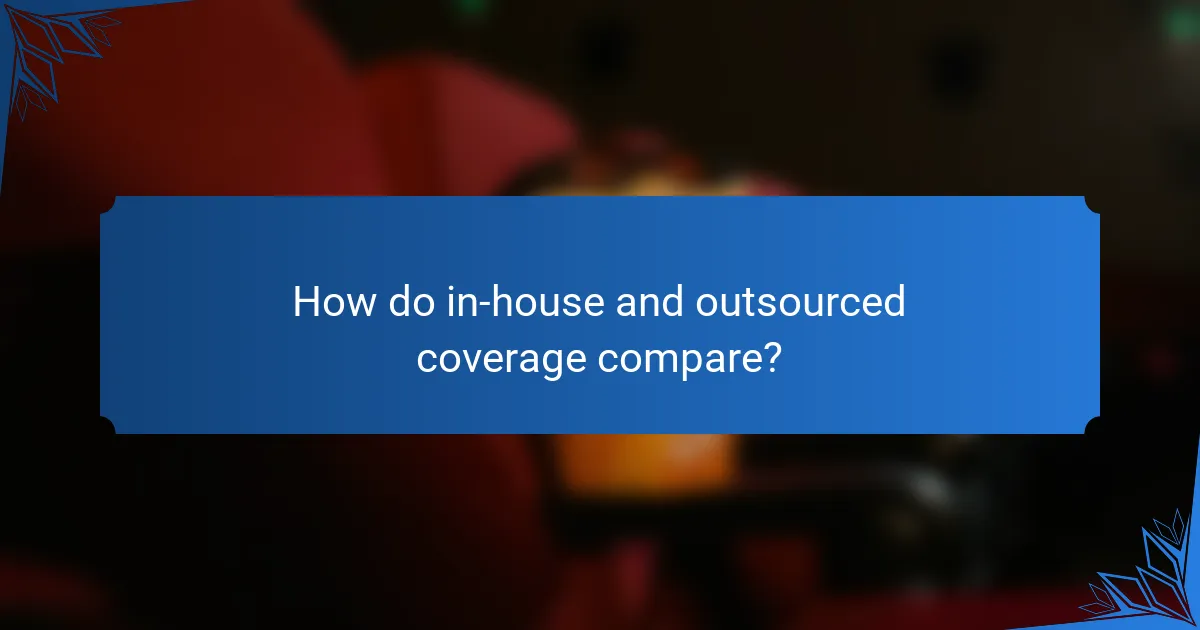When planning celebrity event coverage, organizations face a critical decision between in-house and outsourced options. Each approach presents distinct costs and benefits that can significantly influence the overall value of the event. Understanding these differences is essential for making an informed choice that aligns with specific needs and resources.

What are the costs of in-house celebrity event coverage?
In-house celebrity event coverage involves various costs that can add up significantly. These expenses include staff salaries, equipment, venue logistics, marketing efforts, and insurance, all of which need careful consideration to assess overall value.
Staff salaries and benefits
Hiring a dedicated team for in-house coverage can be one of the largest expenses. Salaries for event coordinators, camera operators, and social media managers can range from mid to high five figures annually, depending on experience and location. Additionally, benefits such as health insurance and retirement contributions further increase these costs.
Consider the size of your team based on the scale of the event. A smaller event may only require a few key roles, while larger events might necessitate a full team, significantly impacting overall budget.
Equipment and technology expenses
Investing in high-quality equipment is essential for effective coverage. Costs for cameras, lighting, sound equipment, and editing software can easily reach several thousand dollars. Renting equipment is an option, but it can still be costly, especially for high-profile events.
Regular maintenance and upgrades are also necessary to keep up with technological advancements. Budgeting for these ongoing expenses is crucial to ensure your coverage remains competitive and professional.
Venue and logistics costs
Venue selection plays a significant role in the overall cost of in-house coverage. Rental fees for event spaces can vary widely, often ranging from hundreds to thousands of dollars per day, depending on location and amenities. Additional logistics, such as transportation and catering, can further inflate costs.
Planning ahead and negotiating with venues can help manage expenses. Always factor in hidden costs, such as setup and breakdown fees, to avoid surprises in your budget.
Marketing and promotion expenses
Effective marketing is essential for maximizing the reach of your event coverage. Costs for promotional materials, social media advertising, and influencer partnerships can add up quickly. Depending on your strategy, these expenses can range from a few hundred to several thousand dollars.
Focus on targeted marketing efforts that align with your audience to ensure a good return on investment. Utilize analytics to measure the effectiveness of your campaigns and adjust your budget accordingly.
Insurance and liability considerations
Securing insurance for your event is a critical expense that protects against potential liabilities. Coverage can include general liability, equipment insurance, and event cancellation insurance, with costs varying based on the event size and location. Expect to pay anywhere from a few hundred to several thousand dollars for comprehensive coverage.
Consult with an insurance professional to determine the necessary coverage for your specific event. This proactive approach can save significant costs in the event of unforeseen circumstances.

What are the costs of outsourced celebrity event coverage?
Outsourced celebrity event coverage typically involves various costs that can significantly impact your budget. Understanding these costs is essential for assessing the overall value of hiring external agencies versus managing coverage in-house.
Agency fees and commissions
When outsourcing celebrity event coverage, agency fees and commissions are primary expenses. These fees can vary widely, often ranging from 15% to 30% of the total project cost, depending on the agency’s reputation and the complexity of the event. It’s crucial to clarify these fees upfront to avoid unexpected charges later.
Some agencies may offer tiered pricing based on the services provided, so it’s advisable to compare multiple agencies to find the best fit for your budget and needs.
Travel and accommodation expenses
Travel and accommodation costs can add up quickly when covering celebrity events, especially if the event is held in a different city or country. Expenses may include flights, hotel stays, meals, and local transportation. Budgeting for these costs can help ensure that you do not exceed your financial limits.
Consider negotiating package deals with travel providers or using local resources to minimize expenses. For instance, booking accommodations well in advance can often lead to significant savings.
Production and editing costs
Production and editing costs encompass the expenses related to filming, sound, and post-production work. These costs can vary based on the quality of equipment used and the length of the final video. Hiring skilled professionals for these tasks is essential, as their expertise can greatly enhance the final product.
On average, production costs can range from a few thousand to tens of thousands of dollars, depending on the scale of the coverage. It’s wise to outline your production needs clearly to get accurate quotes from service providers.
Contractual obligations and hidden fees
Contractual obligations can lead to hidden fees that may not be immediately apparent. These can include cancellation fees, overtime charges, or additional costs for extra services that were not included in the initial agreement. Always read contracts thoroughly and ask for clarification on any ambiguous terms.
To avoid surprises, consider including a detailed scope of work in your contract, specifying what is covered and what may incur additional charges. This proactive approach can help manage expectations and keep costs in check.

How do in-house and outsourced coverage compare?
In-house and outsourced coverage of celebrity events differ significantly in terms of cost, quality, and flexibility. Choosing between them depends on specific needs, available resources, and desired outcomes.
Quality of content produced
The quality of content can vary between in-house and outsourced coverage. In-house teams often have a deeper understanding of the brand and its messaging, which can lead to more tailored and consistent content. Conversely, outsourced teams may bring fresh perspectives and specialized skills that enhance creativity and production quality.
When assessing quality, consider factors such as the team’s experience, the technology used, and the overall production process. For instance, an experienced outsourced team might deliver high-quality video and photography that exceeds in-house capabilities.
Flexibility and scalability
Flexibility and scalability are crucial when planning event coverage. In-house teams may struggle to scale up quickly for large events due to limited resources, while outsourced teams can often mobilize additional personnel and equipment as needed. This adaptability can be particularly beneficial for high-profile events that require rapid adjustments.
Consider your event’s size and scope when deciding. If you anticipate fluctuating needs, outsourcing may provide the necessary agility to respond effectively without the overhead of maintaining a large in-house team.
Access to industry expertise
Outsourced coverage typically offers access to industry experts with specialized knowledge and skills. These professionals often have established networks and insights into the latest trends, which can enhance the overall event experience. In-house teams may lack this breadth of expertise, particularly if they focus on a narrow range of events.
When evaluating options, consider the specific expertise required for your event. If you need specialized skills, such as social media engagement or high-end production, outsourcing may be the better choice.
Long-term relationship benefits
Building long-term relationships with in-house teams can foster a deeper understanding of brand values and audience preferences, leading to more cohesive coverage over time. This continuity can enhance brand storytelling and create a consistent voice across events.
On the other hand, outsourcing can provide access to a diverse range of creative approaches and fresh ideas, but may lack the same level of brand intimacy. Weigh the benefits of consistency against the potential for innovation when deciding on your coverage strategy.

What factors influence the decision between in-house and outsourced coverage?
The decision between in-house and outsourced celebrity event coverage is influenced by various factors including budget, the scale of the event, and the desired brand image. Understanding these elements helps organizations make informed choices that align with their goals and resources.
Budget constraints
Budget is a primary factor when deciding between in-house and outsourced coverage. In-house teams may offer lower costs if resources are already available, while outsourcing can lead to higher expenses due to agency fees and additional services. Organizations should evaluate their financial capacity, considering not just immediate costs but also potential long-term benefits.
For instance, a small event may be effectively covered in-house for a few thousand USD, while larger, high-profile events could require tens of thousands for professional outsourced coverage. It’s crucial to weigh the overall value against the budget available.
Event scale and complexity
The scale and complexity of the event significantly impact the choice between in-house and outsourced coverage. Larger events with multiple celebrities, intricate logistics, and extensive media coverage often benefit from the expertise of specialized agencies. In contrast, smaller, simpler events may be adequately handled by an in-house team.
For example, a local charity gala may only need a few cameras and a small crew, making in-house coverage feasible. However, a major film premiere might necessitate a full production team, advanced technology, and strategic media partnerships, making outsourcing a more practical option.
Brand reputation and image
Brand reputation and image are critical considerations in the decision-making process. Outsourced coverage can enhance a brand’s image by leveraging the expertise and polished presentation of professional agencies. This is particularly important for high-stakes events where public perception is paramount.
In-house coverage might be suitable for brands looking to maintain a more personal touch or a specific narrative. However, organizations should ensure that their in-house team possesses the necessary skills and experience to reflect the brand appropriately. Balancing authenticity with professionalism is key to maintaining a positive brand image.



